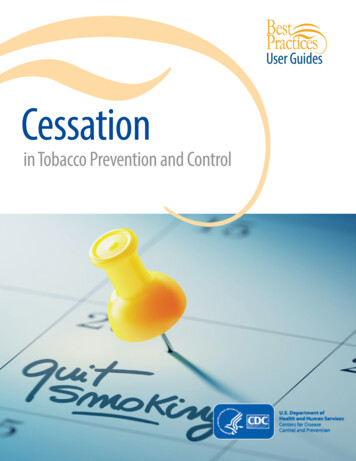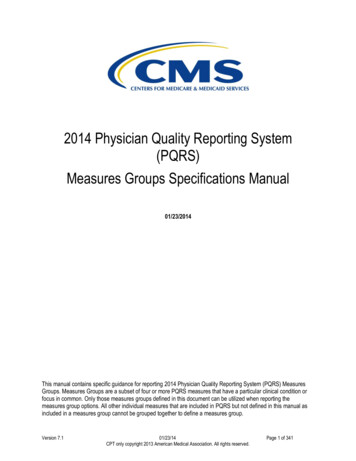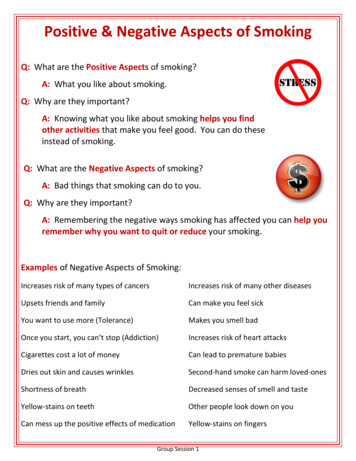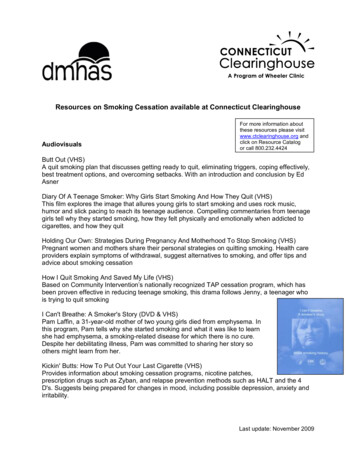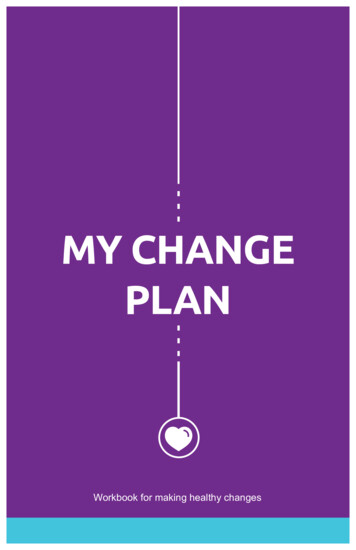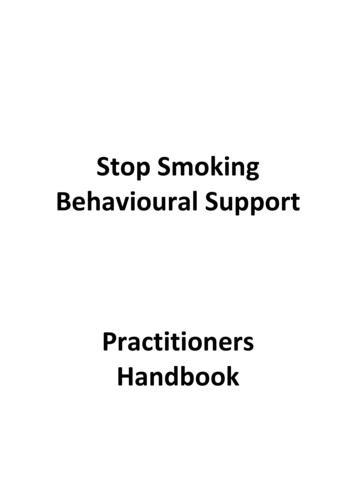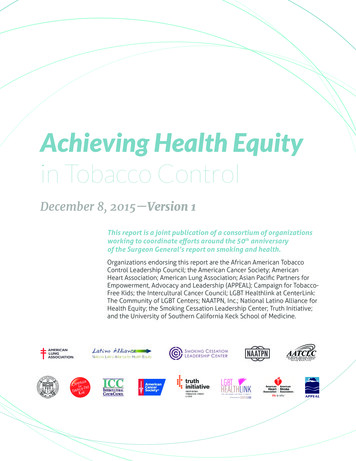
Transcription
Achieving Health Equityin Tobacco ControlDecember 8, 2015—Version 1This report is a joint publication of a consortium of organizationsworking to coordinate efforts around the 50th anniversaryof the Surgeon General’s report on smoking and health.Organizations endorsing this report are the African American TobaccoControl Leadership Council; the American Cancer Society; AmericanHeart Association; American Lung Association; Asian Pacific Partners forEmpowerment, Advocacy and Leadership (APPEAL); Campaign for TobaccoFree Kids; the Intercultural Cancer Council; LGBT Healthlink at CenterLink:The Community of LGBT Centers; NAATPN, Inc.; National Latino Alliance forHealth Equity; the Smoking Cessation Leadership Center; Truth Initiative;and the University of Southern California Keck School of Medicine.
INTRODUCTIONWe believe that further efforts in tobacco control shouldrecognize and give priority to the well-understood fact thatsmoking and tobacco use, and therefore disease, affect certainspecific populations within the United States differently, withsome suffering disproportionately from the tobacco epidemic.This paper sets forth our reasoning and conclusion that in order to improveAmerica’s health, we must find and treat tobacco use and tobacco-relateddiseases where they are most prevalent.Tobacco control efforts have seen great successes since the first SurgeonGeneral’s report on tobacco more than 50 years ago. Nationally, since1964 smoking prevalence has plummeted and now over half of the U.S.population is protected by laws banning smoking in public places.1,2Despite these monumental achievements, programs and servicesdesigned to eliminate the burden of tobacco related-diseases amongour nation’s diverse populations have reached an impasse and, in somecases, such as those with low socio-economic status, tobacco disparitiesare worsening. The data presented below show that smoking continues todisproportionately affect lower-income and less-educated communities;racial and ethnic populations; and the lesbian, gay, bisexual, andtransgender (LGBT) communities. Predatory marketing practices targetingthese communities are no longer covert, but palpable, and technologicaladvances have made both the development and sale of new tobaccoproducts seem an indomitable challenge to overcome.Population-based tobacco control efforts, such as policy change, areeffective, have made an enormous difference and must be continued, butalso must be complemented by new efforts designed to eliminate existingdisparities. The February 2015 Vital Signs Report released by CDC laudednational efforts to protect the U.S. population from secondhand smoke;however, as the report states, 7 in 10 Black children remain exposed. Heartdisease and cancer, both smoking-related illnesses, are the top two leadingcauses of death among African Americans. Although Hispanic/Latinos are agrowing population in the U.S., they are the least likely of any racial/ethnicgroup to have health insurance. Unsurprisingly, heart disease and cancerare also the first and second leading causes of death among Hispanics/Latinos. In 2013, smoking prevalence among American Indians and AlaskanNatives was the highest among all racial/ethnic groups. Native Hawaiians,Pacific Islanders and some Asian American ethnic subgroups have veryhigh rates of tobacco use, including smokeless products, and continueAchieving Health Equity in Tobacco Control page 2 of 25
to require culturally and linguistically tailored tobacco prevention andcessation programs. Similarly, the National Adult Tobacco Survey data showLGBT people smoke at rates 50% higher than others, yet there are fewprograms designed to reach and speak to this population. Lower-incomeand less-educated populations are particularly burdened by tobacco use.Smoking is directly correlated with income level and years of education.Since the release of the Surgeon General’s first report on smoking in 1964,smoking has become ever more concentrated among populations withlower incomes and fewer years of education. People with mental illnessalso face a higher prevalence—and greater challenges—than those withoutmental illness. Mental illness affects nearly 1 in 5 adults and, of that group,36% smoke cigarettes. People with mental illnesses face issues that canmake it more challenging to quit, such as low income, stressful livingconditions, and lack of access to health insurance and healthcare. Just asour communities are diverse with assorted histories, social environments,value systems and mental health factors, so too must our efforts tocombat health disparities be varied. Additionally, adequate resourcesmust be appropriated to develop local capacity and build an empoweringinfrastructure if these efforts are to be sustained.IWhitehead M, Dahlgren G.Levelling Up (Part 1): A DiscussionPaper on Concepts and Principlesfor Tackling Social Inequities inHealth. World Health Organization.Available at http://www.euroho.int/document/ e89383.pdfWe need to continue the population based policies and programs thathave produced such dramatic results, including results that have benefitedmany racial and ethnic populations, but also expand efforts that incorporateand embrace fundamental principles of health equity that afford equaltreatment of all individuals/groups (horizontal) and provide supplementarysupport for individuals/groups that are marginalized (vertical). Healthequity, as understood in public health literature and practice, is whenideally everyone has the opportunity to “attain their full health potential”and no one is “disadvantaged from achieving this potential because ofhis or her social position or other socially determined circumstance.”IMaking advances towards health equity requires institutions to invest ininfrastructure for national public health policy agendas that break fromorthodox practices. A practice of imposing solutions on communitieswithout involving them in their development can frustrate grassrootsefforts. Implementation of authentic principles of health equity will requireinstitutional changes as well as a substantial investment of both time andresources in our communities.A commitment to addressing health equity can be demonstrated in manyways; for example, internal practices. Organizations and institutionscommitted to health equity should have internal hiring practices thatappropriately reflect the populations they want to serve; strategic planningprocesses that involve key community stakeholders at the outset; andfinancial resources allocated to local communities or organizations servingthose communities.Achieving Health Equity in Tobacco Control page 3 of 25
Additionally, organizational priorities should address specific disparities.For instance, since the LGBT communities have higher rates of smoking thanother communities, efforts are needed to reach this often-marginalizedpopulation and support its need for cessation and prevent uptake bythe young. Since an estimated 88% of African American smokers usementholated tobacco products,3 governing agencies should exercise theirauthority to proscribe the sale of mentholated tobacco products to addressthis glaring disparity. While data collection systems do not adequatelyrepresent the diversity of the Asian American, Native Hawaiian, and PacificIslander communities, we should rethink how data is being collected,disaggregated and portrayed for these groups. As tobacco taxes are lowerand secondhand smoke policies oftentimes do not encompass those inrural areas in Southern and Midwestern states,4 regional and state effortsshould be emphasized to address the unequal burden of tobacco-relateddiseases in that region. Finally, tobacco cessation should be made part of anoverall mental health treatment strategy.Eliminating tobacco-related disparities can only occur if we collectivelyadvance principles of health equity. Governments, national organizationsand agencies must be willing to concede some control of the policymaking process to the communities most impacted by the policies. Localcommunities, supported by organizations committed to health equity,should be sufficiently empowered to advocate for policies that addressbarriers to health equity. Researchers should conduct surveillance inpartnership with communities, as opposed to having the community bea target for their research. Finally, everyone should share ownership andaccountability for the success or failure of efforts to incorporate a healthequity frame of reference in the quest to eliminate tobacco-relateddisparities.Achieving Health Equity in Tobacco Control page 4 of 25
THE EVIDENCEOverviewTobacco use is not an equal opportunity killer. Smokingdisproportionately affects those most in need such as thepoor, the homeless, racial minorities, LGBT persons and thosesuffering from mental illness and substance use disorders.While there have been declines in both youth and adult tobacco use inAmerica, gaps in health equity persist. These trends are well documented,having been the subject of many policy statements, academic analyses,and the subject of the 1998 Surgeon General’s report, Tobacco Use amongU.S. Racial/Ethnic Minority Groups. Excellent analyses on this issue havebeen conducted by many groups, such as the Tobacco Research Networkon Disparities, and tobacco control advocacy groups continue to provideupdated data on this issue. The Centers for Disease Control and Prevention(CDC) continues to fund national networks of groups committed toaddressing the ongoing disparate impact of tobacco.The facts are compelling. Americans with lower levels of education andincome are significantly more likely to smoke than more affluent oreducated Americans. Smoking prevalence is 50% higher among LGBTAmericans compared with other Americans. Those grappling with mentalillness comprise nearly a third of all adult smokers. Even among populationswho smoke less than the general population (such as African Americanadults), death and disease is greater than among the general population,partially due to lack of cessation resources and treatment options.Moreover, those groups most impacted by the tobacco epidemic haveconsistently been targets of marketing by the tobacco industry designed tohook them on their deadly product.This document addresses only the highlights of the problem, but eventhese highlights make the case that in order to appropriately address andeventually end the tobacco epidemic in America, all populations must beincluded in developing policies and practices designed to reduce tobaccouse, increase cessation, and improve access to treatment for tobaccorelated disease. Below we summarize key facts on prevalence, cessation,health effects, and marketing among demographic groups most severelyimpacted by the tobacco epidemic.Achieving Health Equity in Tobacco Control page 5 of 25
Low Socioeconomic Status (SES)Smoking Prevalence: In 2013, smoking prevalence was higher among persons living belowpoverty (29.2%) than those living at or above poverty (16.2%).5 Among adults under age 65 in 2012, 30.1% of Medicaid enrollees and29.6% of uninsured individuals smoke, compared to 15.2% with privateinsurance coverage.6 A study of cigarette smoking prevalence in U.S. counties found that,while the U.S. as a whole has made significant progress in reducingsmoking from 1996–2012, rates vary dramatically between counties withdifferent income levels, even within the same state. Counties with higheraverage incomes experienced more rapid declines than counties withlower average incomes.7Cessation: People living below the poverty line are less likely to successfully quitsmoking (5.1%) than those living at or above poverty (6.5%).,8Health Effects: Among the primary causes of death in the U.S., the diseases with thestrongest gradients in SES are those related to smoking, such as chronicobstructive pulmonary disease and lung cancer.9 Occupational exposures place low SES employees in blue collar orworking class sectors (i.e., industrial, service professions) at increased riskof tobacco-related health outcomes, including lung cancer and restrictiveand chronic obstructive lung disease, due to secondhand smoke orchemical and other agents that are synergistic with tobacco smoke incontributing to health outcomes.10Marketing: An analysis of previously secret tobacco industry documents found thattobacco companies strategically marketed their products to low SESwomen by distributing coupons with food stamps, discounting cigarettes,developing new brands, and promoting luxury images to low SES, AfricanAmerican women.11Education LevelSmoking Prevalence: 2013 smoking prevalence was higher for those with a GED (41.4%) orhigh school diploma (22.0%) compared with those with an undergraduatedegree (9.1%) or graduate degree (5.6%).5Achieving Health Equity in Tobacco Control page 6 of 25
Smoking among non-college bound high school seniors is more thantwice that of college-bound high school seniors (25.3% vs. 10.8%,respectively).12 Evidence suggests widening disparities in prevalence over time. NationalHealth Interview Survey data from 1940 to 2000 finds that smokingprevalence in 1940 was lowest among those with less than a high schooldegree (35.8%). Prevalence was higher for those with a high schooldegree (39.4%), some college education (40.8%) or a college degree(40.4%). By 2000, there was a clear negative gradient between smokingprevalence and education: 29.6% of those with less than a high schooldegree smoked, compared with 28.4% of those with a high schooldegree, 25.6% of those with some college and 14.2% of those with acollege degree only.13Cessation: According to data from 2012, quit attempts increase as education levelrises, with only 40% of adult smokers with a high school diploma makinga quit attempt versus 49.0% of those with a college degree.14 According to data from 2010, successful quitting also increases aseducation level rises. 11.4% of adult smokers with an undergraduatedegree have quit successfully compared with only 3.2% of those withless than 12 years of education.8Health Effects: A 14-year follow-up study found that lower education was associated withgreater ischemic stroke incidence, a condition exacerbated by smoking.15Race/EthnicityAfrican AmericanSmoking Prevalence: Survey data from 2013 reported that 18.3 % of African American adultsare current smokers. Smoking among African American men is higher thanamong African American women (21.8% vs. 15.4%).5 African American high school students smoke at lower rates than theirWhite and Hispanic/Latino peers. A 2014 survey found that 4.5% ofAfrican American high school students smoke cigarettes, compared to10.8% of White high school students and 8.8% of Hispanic/Latino highschool students.16Achieving Health Equity in Tobacco Control page 7 of 25
Cessation: Although African Americans tend to be lighter smokers, they have moredifficulty quitting compared with other racial/ethnic groups. Whilemore African American adult smokers want to quit and more make quitattempts than White smokers, African Americans successfully quit at alower rate. Every year, 59.1% of African Americans make a quit attempt,but only 3.3% succeed in quitting compared with 6.0% of Whites.8African American adults are 10–11 times more likely to smoke mentholcigarettes than Whites,17 with the highest rates of menthol smokingamong African American youth aged 12–17.3 Despite starting smokinglater and smoking fewer packs per day, African American mentholsmokers successfully quit at a lower rate than non-menthol smokingAfrican Americans.18 Data from California examining the population-level distribution ofsmokers along the quitting continuum from 1999 to 2008 found thatalthough both Whites and African Americans had achieved progressalong the continuum, successful cessation was lower among AfricanAmericans and the gap widened between 2002 and 2008 for AfricanAmericans compared with non-Hispanic whites.19Health Effects: Heart disease and cancer, both tobacco-related diseases, are the top twoleading causes of death among African Americans.20 African Americans,and particularly males, have experienced lung cancer at higher rates thanWhites for many years. Experts believe that racial differences in smokingbehaviors, socioeconomic factors, and the metabolism of tobaccocarcinogens may all play a role.21,22 Lung cancer kills more African Americans than any other type of cancer.23In 2013, more than 24,000 new cases of lung cancer were estimated tooccur among African Americans and more than 16,000 African Americanswere estimated to die from the disease.23 Data from Missouri show the estimated number of smoking-attributabledeaths and years of potential life lost among Whites and Blacks indicatethat the average annual smoking-attributable mortality rate is 18%higher for Blacks (338 deaths per 100,000) than for Whites (286 deathsper 100,000).24 Menthol cigarettes produce a greater increase in carbon monoxideconcentrations than non-mentholated cigarettes, which may increase therisk of both lung and bronchial cancer more than regular cigarettes.25,26Achieving Health Equity in Tobacco Control page 8 of 25
Hispanic and LatinoSmoking Prevalence: In 2013, smoking prevalence among Hispanic/Latino American adults was12.1% compared with 19.4% among Whites.5 However, wide variationsexist in smoking prevalence across Hispanic/Latino subgroups. While datais limited, national surveillance from CDC collected between 2002 and2005 found that Puerto Ricans had the highest rates of smoking at 31.5%,followed by Cubans (25.2%), Mexicans (23.8%), and Central and SouthAmericans (20.2%).27 In 2014, 8.8 % of Hispanic/Latino high school students reportedsmoking cigarettes. Current smoking rates for Hispanic/Latino highschool students were higher than smoking rates for African Americanstudents but lower than the rates of White students.16Cessation: Though Hispanic/Latino smokers have high motivation to quit, with concernfor health effects on children and the family as a primary motivator,they mostly rely on themselves for cessation, with little use of cessationmedication and healthcare provider advice.28 Some research suggeststhat Hispanic/Latino smokers also experience lower levels of practitionerinquiry regarding patient’s interest in quitting and are less likely to receiveinstruction on how NRTs work relative to non-Latino smokers.29Health Effects: Hispanics/Latinos have among the lowest rates of health insurancecompared with other racial/ethnic groups, such as non-Hispanic whites30,31and African Americans.30 Cancer and heart disease are the first and secondleading causes of death among Hispanics/Latinos, and tobacco use is amajor risk factor.32,33 In 2012, over 8,000 new cases of lung cancer were expected to occuramong Hispanics/Latinos; and more than 5,000 Hispanics/Latinos areexpected to die from this disease.31American Indian/Alaska NativeSmoking Prevalence: 2013 smoking prevalence among American Indians and Alaskan Nativeswas 26.1% compared to 19.4% among Whites, and was the highest amongall racial/ethnic groups.5 According to the National Survey on Drug Use and Health (NSDUH)2008–2010, among both adolescents and young adults, AmericanIndians/Alaska Natives had the highest prevalence of current smoking.34Achieving Health Equity in Tobacco Control page 9 of 25
Cessation: According to the National Health Interview Survey (NHIS) in 2012,American Indians/Alaska Natives had one of the lowest quit ratios at 48.2%compared to Whites at 57.1%.14Health Effects: Smoking contributes to a disproportionate excess of mortality and diseaseamong American Indian/Alaska Natives compared with Whites.35 From 2001 to 2009, age-adjusted death rates, smoking-attributablefractions, and smoking-attributable mortality for all-cause mortalitywere higher among American Indian/Alaska Native men and women thanamong White men and women.35 Recent data has found that smoking causes 21% of ischemic heartdisease, 15% of other heart disease, and 17% of stroke deaths inAmerican Indian/Alaska Native men, compared with 15%, 10%, and 9%,respectively, in White men.35 Among American Indian/Alaska Native women, recent data demonstratesthat smoking causes 18% of ischemic heart disease deaths, 13% ofother heart diseases deaths, and 20% of stroke deaths, compared with9%, 7%, and 10%, respectively, among White women.35Asian AmericanSmoking Prevalence: Smoking prevalence in 2013 was 9.6% among Asian American adultscompared with 19.4% among Whites.5 Asian American men smoke at asubstantially higher rate —15.1%, compared with 4.8% of Asian Americanwomen.5 Smoking prevalence varies greatly by gender, ethnicity, andlanguage fluency across different Asian American communities. While datais limited, national surveillance from 1999–2001 found prevalence rangingfrom 12.3% among Chinese-American adults to 27.2% among KoreanAmerican adults.36 Local community studies conducted in the 1990s have shown thatmales among certain Asian American ethnic groups actually have someof the highest smoking prevalence in the U.S.37 This emphasizes theneed for current research regarding non-heterogeneous Asian Americanpopulations.Health Effects: Cancer was the leading cause of death for Asian Americans or PacificIslanders as of 2010.38 A study in California found that Chinese people had the highest mortalityrates for lung and bronchial cancer among all Asian subgroups.39Achieving Health Equity in Tobacco Control page 10 of 25
Native Hawaiians and Pacific IslandersSmoking Prevalence: Data have also shown very high smoking prevalence among NativeHawaiian and Pacific Islanders, particularly among men. National data findsmoking rates of 41.9% among Native Hawaiian/Pacific Islander men and27.0% for Native Hawaiian/Pacific Islander women.27 Statistics among Native Hawaiian and Pacific Islander youth are alsodisconcerting. Nationwide, Pacific Islander youth smokers start earlierthan any other ethnic or racial group, with 31.1% starting to smoke ingrade school.40 The Global Youth Tobacco Survey [GYTS] conducted in the Pacific Islandsrevealed a smoking prevalence of 43.1% among Guam boys aged 13–15years.41Marketing to Racial and Ethnic Groups A recent systematic review on neighborhood disparities in point-of-saletobacco marketing found that neighborhoods with lower income havemore tobacco marketing. The study also found that there is a higherprevalence of marketing of menthol cigarettes in urban neighborhoodsand neighborhoods with more African American residents, whilesmokeless tobacco was more prevalent in rural neighborhoods and areaswith more White residents.42 Several studies have found a greater number of tobacco advertisementsand a larger presence of menthol cigarette advertising in AfricanAmerican neighborhoods.43–47 A 2011 study of cigarette prices in retail stores across the U.S. foundthat Newport cigarettes, the top selling menthol cigarette brand in theU.S.48 and the most commonly used among African American youth,3 aresignificantly less expensive in neighborhoods with higher proportions ofAfrican Americans.49 A study of neighborhoods with high schools in California found thatas the proportion of African American high school students rose, theproportion of menthol advertising increased, the odds of a Newportpromotion were higher, and the cost of Newport cigarettes was lower.50 Some research has found that lower-income communities are more likelyto have tobacco advertising within 1,000 feet of schools than higherincome communities.44 A higher density of such retailers near schoolshas been found to increase experimental smoking among high schoolstudents.51–53Achieving Health Equity in Tobacco Control page 11 of 25
The tobacco industry has targeted African American communities byusing urban culture and language to promote menthol cigarettes,sponsoring hip-hop bar nights, and targeting direct-mail promotions.54 Marketing to Hispanics/Latinos and American Indians/Alaska Nativeshas included the promotion of cigarette brands with names such as Rio,Dorado, and American Spirit.54 Hispanic and Latino neighborhoods tend to have a high concentrationof retail tobacco outlets,55,56 and these neighborhoods have significantlymore businesses selling tobacco products to underage consumers.57 Tobacco companies have sponsored cultural events tied to racial andethnic culture, including Mexican rodeos; American Indian powwows;racial/ethnic minority dance companies, parades, and festivals; Tetfestivals; Chinese New Year and Cinco de Mayo festivities; and activitiesrelated to Black History Month, Asian/Pacific American Heritage month,and Hispanic Heritage Month.58LGBTSmoking Prevalence: In 2012, the smoking rate was 68% higher among LGBT adults (32.8%)versus others (19.5%).100 Smoking rates stayed at least 50% higher insubsequent waves of data collection.5 Overall, sexual minorities are 1.5 to 2.5 times more likely to smokecigarettes than their heterosexual counterparts.59 Bisexual women areup to three and a half times more likely to be smokers than heterosexualwomen.59 Smoking rates among LGB youth are estimated to be considerably higher(38%–59%) than those among adolescents in general (28%–35%).However this data is from a review that covers 1987–2000.60 Newresearch on smoking among LGB youth is needed. Several factors such as higher levels of social stress,61 frequent patronageof bars and clubs,62 higher rates of alcohol and drug use,63 and directtargeting of LGB consumers by the tobacco industry64,65 may be related tohigher prevalence rates of tobacco use among LGB groups compared tothe general population.Cessation: Data on interest in quitting, quit attempts and successful smokingcessation among LGBT populations is very limited. A 2012 study using aconvenience sample of LGBT smokers in Colorado found that only 47.2%had made a past year quit attempt.66Achieving Health Equity in Tobacco Control page 12 of 25
Although lesbians and women who have sex with women (WSW) smokeat high rates, one study found that lesbian periodicals had the fewestcessation ads: only eight appeared over a ten-year period, compared toover 1,000 in periodicals targeted to gay men.67Marketing: Industry documents show that tobacco companies were aware of highsmoking rates among sexual minorities, and marketing plans illustratethe companies’ efforts to exploit the LGBT market.68–70 Analysis of tobaccomarketing has demonstrated lesbian and gay youth as an emerging targetcommunity.71 One tobacco industry document explained, “A large percentage of gaysand lesbians are smokers. In order to grow the Benson & Hedges brand, itis imperative to identify new markets with growth potential . . . Gays andLesbians are good prospects for the Benson & Hedges brand.”68 The tobacco industry has targeted gays and lesbians through directadvertising in LGBT publications and indirect advertising in mainstreampublications, community outreach and community promotions(such as “LGBT bar nights featuring specific cigarette brands”), eventsponsorships, and the provision of advertising dollars.72 In 1995, a tobacco company conducted a marketing plan called “ProjectSCUM” (Sub Culture Urban Marketing) targeting urban San Franciscopopulations, including gays.70Mental Illness & Substance Use DisordersSmoking Prevalence: Data from 2009–2011 indicate that more than 1 in 3 adults (36%) withmental illness smoke cigarettes, compared with about 1 in 5 adults (21%)without mental illness.73 40% of all cigarettes are smoked by adults with mental illness and/orsubstance use disorders.74 The 2001–2002 National Epidemiologic Survey on Alcohol and RelatedConditions found approximately 46.2 million adults used both alcoholand tobacco in the past year and approximately 6.2 million adultsreported both an alcohol use disorder and dependence on nicotine.75Cessation: National data indicates that the quit ratio, or the proportion of smokerswho have quit, is only 34.7% among adult smokers with any mentalillness compared with 53% among non-mentally ill adult smokers.73Achieving Health Equity in Tobacco Control page 13 of 25
People with mental illness are more likely to have stressful livingconditions, be low income, and lack access to health insurance, healthcare, and help quitting.76–78 All of these factors can make it morechallenging to quit.73 Less than half of substance abuse treatment centers (42%) offer tobaccocessation services.79 A meta-analysis of 19 randomized controlled trials evaluating tobaccotreatment interventions for individuals with substance abuse problemsfound a 25% greater likelihood of long-term abstinence from alcoholand drugs when nicotine dependence treatment is included with othersubstance use treatment.80Health Effects: An estimated 200,000 smokers with mental illness and substance abusedisorders die from tobacco-related disease each year due to elevatedsmoking prevalence in this group.81 People with serious mental illness die 25 years earlier on average thanthe general population. Top causes of these premature deaths includecardiovascular and pulmonary disease and diabetes mellitus—illnessesexacerbated by smoking.82,83 Individuals in treatment for alcohol dependence are more likely to diefrom their tobacco use than their alcohol use.84 A study of long-term narcotics addicts in the 1970s and 1980sconcluded that individuals with drug problems who also smoke are fourtimes more likely to die prematurely relative to individuals with drugproblems who do not use tobacco.85Marketing: The tobacco industry has marketed cigarettes to populations with mentalillness, funded research to show that persons with mental illness usenicotine to alleviate negative mood, provided free or cheap cigarettes topsychiatric facilities, and supported efforts to block smoke free psychiatrichospital policies.73,86,87HomelessSmoking Preval
Achieving Health Equity in Tobacco Control page 6 of 25 Low Socioeconomic Status (SES) Smoking Prevalence: In 2013, smoking prevalence was higher among persons living below poverty (29.2%) than those living at or above poverty (16.2%).5 Among adults under age 65 in 2012, 30.1% of Medicaid enrollees and 29.6% of uninsured individuals smoke, compared to 15.2% with private

